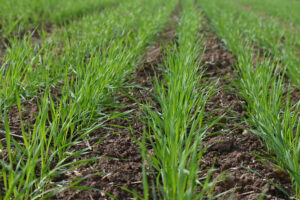Menu
Fall Wheat Management for Higher Yields
The early summer of 2025 made it challenging to harvest high-quality, high-yielding wheat in the Mid-Atlantic Region. As we prepare to plant another wheat crop this fall, it’s important to plan carefully for success in 2026.
Optimum Planting Window
Selecting good genetics is foundational for high yield wheat. The optimum planting window typically runs from late September through about October 10. For earlier planting dates, take care to manage the Hessian fly and aphids. Across southern Pennsylvania, the fly-free date generally falls between September 25 and October 1. Genetic resistance, seed treatments, and monitoring the fly-free date are effective strategies to keep these pests in check. Timely planting and good stand establishment are critical for fall tillering, which sets the stage for high yields.
Seed Placement and Depth
Uniformity and seed placement depth are often overlooked but crucial. A depth of 1¼–1½ inches is preferred. Shallower seed placement leaves the crown vulnerable to winterkill, reduces uniformity, limits root development and can lower tiller expression. Heavy residue in no-till systems can also interfere with consistent seed-to-soil contact. Uneven seed depth quickly reduces yield potential, so precision matters. For challenging residue management, ask your PowerAg Rep about Shred-It.
Seeding Rates and Stand Goals
High-yield wheat depends on adequate seeding rates and tillering. Seeding rates vary up to 1.8 million seeds per acre, targeting 30–40 established plants per square foot. We hope to see at least 4-5 good tillers per plant to maximize head expression. The goal is 60–80 mature heads per square foot, with each head representing approximately 1.5 bu/acre. You can do the math, 80 well filled, mature heads can push yields well above 125 bu/A.

Fertility for Fall Growth
Strong fall tillering requires adequate fertility.
- Phosphorus and Potassium: 300 lbs. of a P/K blend in the fall is a good starting point. Phosphorus is essential for stand establishment and fall tillering.
- Copper also stimulates tiller growth. Adequate copper increases tillering and builds stronger roots, improves winter survival, boosts disease resistance, driving higher yield potential. Copper can be applied in the fall with an herbicide or fungicide.
- Nitrogen and Sulfur: Apply 15–30 units of N with 3–5 units of sulfur in the fall. Whenever applying nitrogen, we recommend using CarbonMaxx. Remember, if you have heavy residue cover, that a significant amount of Nitrogen will be absorbed into the existing crop residue.
Fall Fungicide Considerations
More growers are recognizing the benefits of a fall fungicide application to protect seedlings into the fall and beyond. Diseases like Strawbreaker or Eyespot require fall applications for effective control, and certain areas of Pennsylvania face real risk from this pathogen.
Herbicide Timing
Rough stalk bluegrass, Italian ryegrass, and Marestail are hard to control weeds that we really need to be addressing with fall herbicide applications. Controlling these weeds while they’re small and in the fall is a very effective crop plan.
Timing and Attention to Detail
Timing is everything in high-yield wheat production. The fall and spring windows are short but decisive. The difference between good and great wheat yields is timing and details. Planting depth, fertility, and pest management are all details that add up to higher yields.
As you plan for higher yields, contact your PowerAg sales representative for recommendations on fertility, herbicide, and fungicide programs designed for high yielding wheat.


